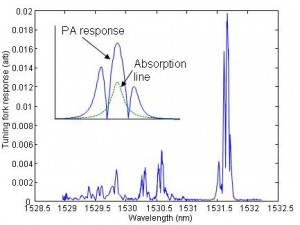Microscale Photoacoustic Sensing
Photoacoustic spectroscopy [1] is an optical absorption spectroscopy whereby the absorbed optical power is detected indirectly by sensing the thermal excitation and expansion of the sample using microphones or other mechanical displacement sensors. For trace-gas-sensing, specificity is achieved by tuning the optical excitation source to the narrow band absorption lines of the gas of interest. The accessibility of photoacoustic spectroscopy has improved due to the availability of inexpensive tunable diode-laser sources developed for telecommunications applications and continued innovation in semiconductor active materials [2] [3] is opening new spectral windows for detecting a wider variety of gasses. Photoacoustic detection of optical absorption has favorable scaling properties for miniaturization [4] and miniature photoacoustic cells have been investigated [5] along with compact resonant quartz tuning fork detectors [6].
We are developing a photoacoustic spectroscopy system to perform distributed gas sensing using fiber optics and quartz tuning fork detectors. A schematic of the system is shown in Figure 1, where multiple photoacoustic detectors share one or more laser sources through a fiber optic switch. For each detector, the distal end of the optical fiber is aligned to terminate in between the tuning fork tines. Photoacoustic excitation of the tuning fork occurs when the target gas periodically absorbs energy from the wavelength modulated laser as the wavelength sweeps across the gas absorption line. Absorption spectra can be measured by tuning the center wavelength of the laser as shown in Figure 2.
- Figure 1: Schematic of distributed gas-sensing system. Laser diodes can be centrally controlled and shared among multiple photoacoustic sensor heads.
- Figure 2: Absorption spectrum of ammonia gas at approximately 190 torr. The inset shows a simulated response to an absorption peak that highlights how each absorption line generates three lobes in the photoacoustic tuning-fork response.
References
- G.A. West, J.J. Barrett, D.R. Siebert, and K.V. Reddy, “Photoacoustic spectroscopy,” Review of Scientific Instruments vol. 54, no. 7, pp 797-817, 1983. [↩]
- S. Schilt, A. Vicet, R. Werner, M. Mattiello, L. Thevenaz, A. Salhi, Y. Rouillard, and J. Koeth, “Application of antimonide diode lasers in photoacoustic spectroscopy,” Spectrochimica Acta Part A, vol. 60, pp 3431-3436, 2004. [↩]
- B.A. Paldus, T.G. Spence, R.N. Zare, J. oomens, F.J.M. Harren, D.H. Parker, C. Gmachl, F. Cappasso, D.L. Sivco, J.N. Baillargeon, A.L. Hutchinson, and A.Y. Chao, “Photoacoustic spectroscopy using quantum-cascade lasers,” Optics Letters, vol. 24, no. 3, pp. 178-180, Feb. 1999. [↩]
- S.L. Firebaugh, K.F. Jensen, and M.A. Schmidt, “Miniaturization and integration of photoacoustic detection,” Journal of Applied Physics, vol. 92, no. 3, pp. 1555-1563, Aug. 2002. [↩]
- P.M. Pellegrino and R.G. Polcawich, “Advancement of a MEMS photoacoustic chemical sensor,” in Proceedings of the SPIE, vol. 5085, 2003, pp. 52-63. [↩]
- S.G. So, O. Al Rifai, G. Wysocki, A.A. Kosterev, and F.K. Tittel, “Advanced embedded control and data acquisition systems for laser-based quartz-enhanced photoacoustic spectroscopy,” in Proceedings of IEEE Sensors 2007, pp. 1279-1282. [↩]

